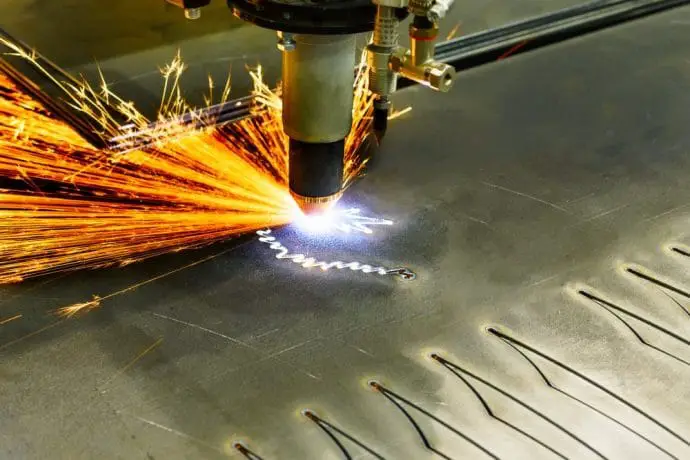In the manufacturing industry, both plasma cutting and laser cutting are used regularly – and they both have a variety of different benefits. In this article, we’ll examine Plasma vs laser cutting, and explore how each method can be used in the cutting industry.
Let’s get started now!
Plasma Cutting – The Basics
Plasma cutting has been around for a bit longer than laser cutting. Plasma cutting was first used in the 1960s, and became popular in the 1980s – so it’s been used for quite a while.
Plasma cutting works by firing specialized gas out of a nozzle. An electric arc is formed between this gas and an electrically-conductive metal, creating plasma. This electric discharge superheats the plasma, allowing it to cut through metal of any kind.
That’s one of the main differences between plasma cutting and laser cutting. Plasma can only cut metals – it cannot be used on other materials like rubber, wood, or ceramics because it requires an electrically conductive material.
However, unlike laser cutting, plasma cutting has no limit to the types of metals which can be cut. This makes it one of the most versatile tools in the metal cutting industry – as it can be used for metal alloys of any kind.
Plasma cutting typically is able to cut metals in a tremendous variety of thicknesses – between 1mm-80mm. It’s also quite fast, able to cut at a speed in excess of 20 meters/minute.
However, one drawback of plasma cutting is that it can often warp or damage the edges of a metal, requiring additional finishing steps like polishing and refinishing.
Typically, plasma cutting is used for high-volume cutting projects that require precision cutting of very thick metals. It excels at this application – and is definitely the best choice if you are cutting a variety of heavy-duty metal alloys.
Laser Cutting – The Basics
Laser cutting machines use two different types of technologies. CO2 lasers use high-powered, gas-based lasers to cut through a variety of different metals. However, CO2 lasers cannot cut highly-reflective materials like copper, aluminum, and brass.
Fiber lasers use a high-powered laser and a specialized optical fiber. The laser is “contained” within this fiber, which heats up and can cut through metal of any variety.
One of the primary differences between plasma and laser cutting is that laser cutting can be used on any material – not just metals. You can use laser cutting machines on wood, ceramics, acrylics and plastics, and more.
Another difference between plasma cutting and laser cutting is that laser cutting can be used for detail work such as engraving, as well as structural work like welding and drilling. This allows multiple manufacturing steps to be accomplished within a single machine.
Laser cutting is very accurate and precise. Usually, laser-cut materials do not require any further refinishing to remove warped or imperfect edges, which can further increase project turnaround time.
The speed of a laser depends primarily on the thickness of the material it’s cutting. Thinner metals can be cut at very high speed, but as the material thickens, the time to cut increases quite a bit.
Typically, laser cutting is limited to materials that are about 25mm in thickness. This means plasma is a much better choice for extremely thick metals.
Because it’s so fast and versatile, laser cutting is usually used in projects that use require multiple different types of materials, use relatively thin materials, and require a fast turnaround time.
What’s The Best Kind Of Cutting Method For Me?
There is no “best” cutting method – and most cutting/machine shops utilize both laser and plasma cutting, as well as traditional stamping machines and hydro-cutters.
Overall, laser cutting is better for detail work, and it’s more versatile because it can be used with any material – not just metals. However, thick or highly-reflective metals can pose serious problems for laser cutters.
That’s where plasma cutting excels. The sheer power of plasma cutters allows for the efficient cutting of metals up to 80mm in thickness.
So, the answer is – both! Both laser cutting and plasma cutting complement each other perfectly – they each have their own benefits, and specialized applications where they excel.

